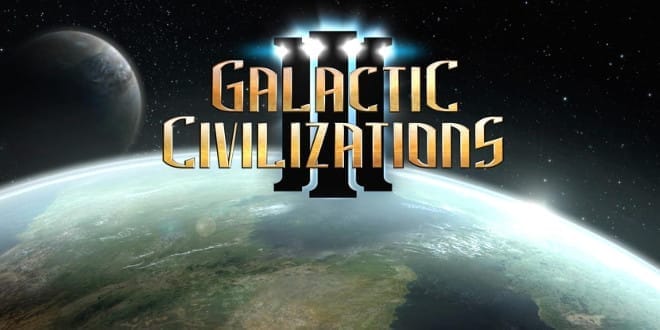Are you familiar with Stardock? If you are, it's probably because of their Galactic Civilizations series. I remember the unending buzz around the original GalCiv back in the early 2000s. It's easy to recall how different and mysterious the title felt to me then. These days, however, we can see that Galactic Civilizations III is less an innovative and mysterious contestant and more of a highly refined standard within the 4X genre. The question is, is there enough refinement to truly qualify Galactic Civilizations III as a worthy sequel? Let's examine that question and a few others in this review.
https://www.youtube.com/watch?v=NlkC1lkvG-Q
First, a brief recap of the series for those that are unfamiliar with the title. GalCiv is a turn based strategy trilogy where players colonize planets from within an expansive galaxy. Through careful resource management and planning, a player progresses to one of many victory conditions.
Several types of resources are produced and spent towards researching technologies and building planetary structures and/or ships. There are many tools at a player's disposal to achieve victory – such as diplomacy, cultural influence, trade, scientific advancement and, of course, war. Some might go so far as to call it Civilization on a galactic level, and now that I think about it, they might be on to something there. Seeing as I'm not terribly familiar with the Civilization franchise I wonder if you readers think these titles are similar? Does GalCiv borrow heavily from Civilization?
Anyhow, now that we have a basic understanding of the series, let's take a look at how GalCiv III has been upgraded and improved compared to its predecessors. One notable change is that the series has evolved from grid-based movement and structural placement to a hex-based system. This is a welcome upgrade because it allows for more points of adjacency for planetary structures. If you don't know what I'm talking about, just imagine a system were the buildings you place are granted bonuses from being situated next to like-structures. Hexes mean six points of adjacency whereas a grid meant only four. So planetary engineering just got a little more interesting.
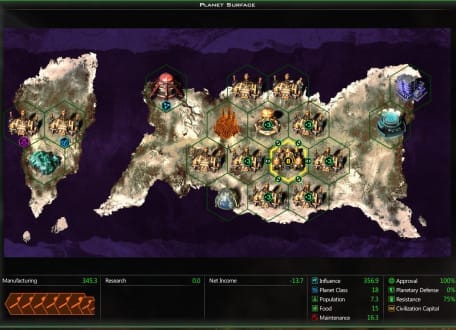
Of course, there is the obligatory upgrade in graphics. They look nice. I mean, the series has always been more or less on-par with the times as far as graphics are concerned. They are by no means mind-blowing, but I'd say they're slightly better than adequate.
One new feature that compliments the upgraded graphics is the improved battle viewer. The fully 3D cinematic-mode really allows players to appreciate their fleets and weapons. If you like to build your own ships like I do, the cinematic battle viewer will serve to display the fruits of your labor. While this type of exposition is rare and appreciated in a 4X game, in GalCiv III it's still a pretty lack-luster feature. When viewed cinematically, ships can be seen to travel in bizarre and physics-defying patterns. What ensues doesn't really look like an epic space ballet of war, but more like an awkward space-prom. Still, the cinematic viewer really does serve to showcase the extensive array of ships and weapons that GalCiv III brings to the table.
In the video below you can check out my weird custom ships in the cinematic battle viewer.
Of course, players will be met with a new saga in story mode. If you are new to the series, or just new to the storyline, you may find yourself a little lost. The story takes place right after the events of ... I don't even know! I never played through the story in the previous games/expansions, so it took me some time to understand the events surrounding the current situation. Fortunately, the present conflict is easy enough to comprehend. The bad guys have grown strong. Earth is hiding behind some kind of precursor shield. You are elsewhere with ships and resources, looking to obtain a good position to launch your attack and hopefully save earth.
If you can stomach not having a totally customized race and galaxy, the campaign does have a couple of cool things to offer. First, there are some pretty high quality cut-scenes to enjoy. Second, your main character will have more flavorful and narrative driven dialog. Dialog options that usually come in Good, Evil, and Neutral variates. A player's moral choices will later bear fruit in the form of bonuses. Finally, players are also granted a mega powerful capital ship. More powerful by far than any other ship I've encountered.
So its fairly easy to see that the campaign has something to offer players that can wrench themselves away from user-generated scenarios — even if it does force us to play as boring old humans.
Speaking of user-generated scenarios, in this type of scenario, players can customize a random galaxy, their race, their opponents, and many other gameplay factors. I really get into this customization! I love to meticulously create my own alien species and role-play my conquest of the galaxy. Galactic Civilizations III greatly supports this type of play, as there are tons of stats, attributes, bonuses, flavor text, and graphics that a player can customize their race with. If this isn't enough customization for you, know that you can also design each and every ship in your fleet.

Indeed, creative players may even find the gameplay taking a back seat to ship design. It's easy to drop 10s of hours in the ship builder. I know I did. If you're not familiar with this tool, it's a very versatile feature that allows you to build tons of different types of space vessels. You can even make parts that move and rotate. Unfortunately, it's a bit of a mess. Some tools work intuitively and some are just wonky. There's certainly a lot of room for refinement here, but with patience, it gets the job done beautifully.
With all this customization available, it's hard not to really get into role playing your species. For example, in my last game I created an insectoid race, The Mantis. I played them as a solitary and antisocial species that avoided other races. However, if trifled with they would attack, refusing to relent until the worlds of their opponents were devoured. I painstakingly manufactured ships for them that resembled hives and plant-life.
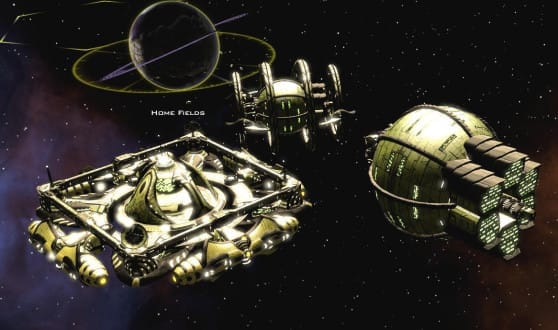
The length of a game can vary depending on map size, but in general it has taken me around 20 to achieve victory. This brings up something I want to address concerning victory conditions. It seems that the easiest way to win is through war and conquest. This leaves the other victory conditions seeming unbalanced and underpowered. Indeed, non-war or influence victories takes two to four times longer to achieve. Micromanaging 20 planets while you slowly crawl towards a research or ascension victory (A victory that you are pretty much guaranteed.) is extremely tedious.
One new feature that exacerbates this problem is the Technological Age system. This is divided into four tiers. Expansion, War, Ascension, and a final unnamed tier. In order to research tech in a higher tier, a player will have to research technologies from the current and lesser tiers – up to 100 of them! This is disastrous! Are you a peaceful species? Too bad, you better research 60% of the warfare tree just to meet the requirements to get to the next technological age.
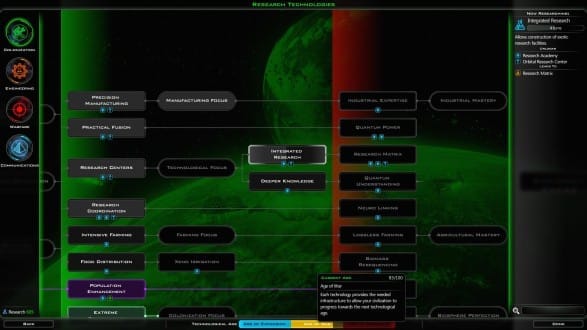
This age system ensures that no matter how one is role-playing their race, they will have to painstakingly research several technologies that do not fit their play style or offer any particular benefit for the current scenario. It also just slows things up. No matter how much research a player produces, they may not learn more than one technology per turn. Thus, no matter how far ahead of everyone else a player is, making it to the next age usually demands at least 80 to 100 turns!
Still, don't be put off by these complaints. They are pretty minor compared to the enjoyment I had with the rest of the game. I spent about 70 hours playing GalCiv III and I have no regrets. Even with a few flaws, what gamers are left with is a highly polished, fully featured 4X title. Galactic Civilizations III has everything one expects from the 4X genre: events, customizable units and factions, cute little cutscenes when one makes major accomplishments and much more.
It's also worth pointing out that the replayability of Galactic Civilizations III is through the roof. It's one of those titles that you can rediscover a year later and enjoy it just as much as when you first purchased it.
If we compare GalCiv III to its predecessors, we can see that at this point, some diplomacy options seem to be missing and spying is gone entirely. But fans shouldn't worry, because I really didn't find myself missing these features. In the end, not a lot has changed with the series. It's still basically the same GalCiv its always been, but that's not a bad thing. Sometimes we just want an updated and modern version of our favorite titles, and in that regard GalCiv III delivers in full.
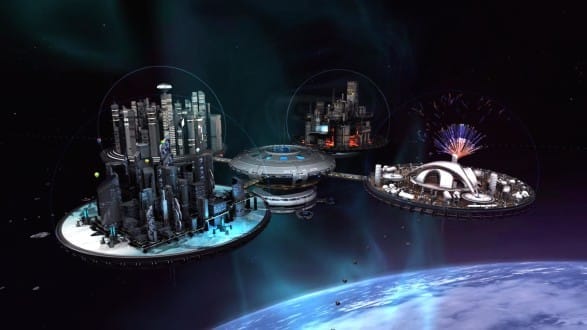
This game was purchased by me and played on a Windows PC.
Review Summary
Galactic Civilizations III is more of the same with some nice upgrades and a handful of new features, and I have no complaints about that. A great starting point for new players, and an even nicer reason to take up an old addiction for veterans.
(Review Policy)Have a tip, or want to point out something we missed? Leave a Comment or e-mail us at tips@techraptor.net
